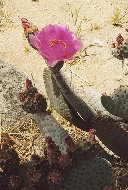
For the next two years or so, Boyd and Hoppy were off the screen. During this time, Boyd purchased the rights to the films and character. He also formed his own production company to resurrect the Cassidy cinema adventures. Brand new Hopalong flicks hit the silver screen beginning with FOOL'S GOLD in 1946. A dozen were made and released by United Artists during 1946-1948, and the Cassidy film finale, STRANGE GAMBLE, arrived at movie houses in late 1948. In this UA dozen, Andy Clyde returned as Hoppy's sidekick and the new member of the team was Rand Brooks who did a creditable job as the impulsive 'Lucky Jenkins'. But this was post World War II time --- film production costs had skyrocketed, people's movie tastes and habits were changing, and the B western was fading. Thus, this final batch of Cassidy westerns are not on par with the earlier films. A newfangled gadget called television arrived to save the day, and the end result was a significant financial windfall to Boyd. The Hopalong Cassidy films were first shown on the Paramount-owned KTLA TV station in Los Angeles. Then they became a network broadcast over NBC, and early Sunday evenings became 'Hoppy night'. Nielsen ratings for the one-hour Cassidy NBC program were solid --- 9th place for the 1950-51 season and in 28th place for 1951-52. The movies were edited down to about 54 minutes to fit both film and commercials into a one hour time slot. I remember being mesmerized when I watched the Hoppy yarns on our first TV set, which I vaguely recall was an Emerson with a ten or twelve inch screen. For the 1952-53 and 1953-54 seasons, there were 52 half-hour Hoppy adventures. A dozen were created (condensed) from the later United Artists films with Andy Clyde and Rand Brooks. And 40 brand new half hour shows were lensed and featured Edgar Buchanan as 'Red Connors'. The end result of all this air time was that Boyd and the Hoppy character were more popular than ever. In addition to TV, Boyd did circuses, rodeos, personal appearance tours, hospital visits, et al. He brought the Hoppy series to radio ... he opened up his own Hoppyland theme park ... and merchandising included hats, gunbelts, lunch buckets, clothing and more. There was also a long running series of comic books. He was on the covers of magazines such as Life, Look and TV Guide. Gosh ... I was the proud owner of an official Hopalong Cassidy twin capgun set that had black holsters made out of real leather. The Cassidy films, particularly the 1935-1941 Paramount releases, are a definite notch or two above the typical B western, and the production quality and higher budgets are immediately apparent. Plus, the scripting and plots were good, the photography was superb, and about half were filmed at scenic Lone Pine, California. Additionally, the running times were much longer than the normal 55-60 minute western programmer --- as best I can recall, the longest Hoppy film ran a tad over 80 minutes. As to William Boyd the man, he had gone through a personal transformation and re-awakening. Boyd had three unsuccessful marriages (to Ruth Miller, Elinor Fair and Dorothy Sebastian). In 1937, he and actress Grace Bradley tied the knot, and the result was a happy pairing that continued through Boyd's death in 1972 of heart problems and parkinson's disease. A few years prior to his passing, Boyd had cancer surgery. They adored each other, and in interviews, Grace mentions the tough times when they had to sell most everything to come up with the dollars to acquire the Hopalong Cassidy rights. Over the years, William Lawrence Boyd --- and his version of the Hopalong Cassidy character --- blended together to became one and the same. The parents and kiddies of the time loved him. And through personal appearances and such, Boyd returned that love and adoration --- you could see it in his face and smile and hear it when he belted out one of his great laughs. Many kids who grew up in the late 1940s and early 1950s owe some of their personal values and beliefs to William Boyd. That's his greatest accomplishment.






